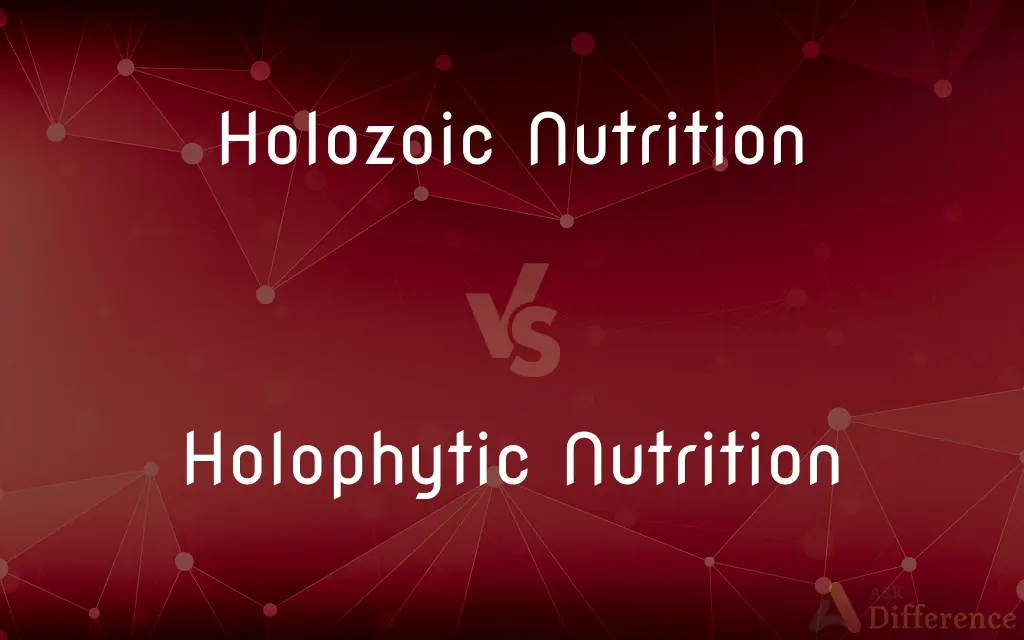Holozoic Nutrition vs. Holophytic Nutrition — What's the Difference?
Edited by Tayyaba Rehman — By Fiza Rafique — Published on December 23, 2023
Holozoic nutrition involves the intake of solid organic food, which is digested and absorbed; holophytic nutrition involves synthesizing food through photosynthesis.

Difference Between Holozoic Nutrition and Holophytic Nutrition
Table of Contents
ADVERTISEMENT
Key Differences
Holozoic nutrition is a mode of heterotrophic nutrition where organisms consume solid organic matter. This process is common in many animals. They take in whole food, which undergoes a process of digestion, leading to the absorption of nutrients. On the other hand, holophytic nutrition is a mode of autotrophic nutrition where organisms synthesize their own food. This is achieved primarily through the process of photosynthesis.
Holozoic nutrition often involves various steps, starting with ingestion, where food is taken into the body. This is followed by digestion, where the food is broken down. In contrast, holophytic nutrition bypasses these steps, as the organism produces food internally. In holophytic nutrition, carbon dioxide and water, in the presence of sunlight, are converted into glucose and oxygen.
In holozoic nutrition, after digestion, the absorbed nutrients are transported throughout the organism to be used or stored. The waste products are then excreted. With holophytic nutrition, there's no ingestion of external food, so no waste products from digestion. However, oxygen is released as a by-product during photosynthesis.
Holozoic nutrition is commonly seen in animals like humans, birds, and reptiles, while holophytic nutrition is mainly observed in plants and some bacteria. The fundamental difference between the two lies in the way they acquire or produce their food. Holozoic organisms depend on other living organisms for nutrition, whereas holophytic organisms are largely self-sustaining.
Lastly, holozoic nutrition requires more complex systems, such as a digestive system, to process food. Holophytic nutrition, on the other hand, requires structures like chloroplasts (in plants) to facilitate photosynthesis and food synthesis.
ADVERTISEMENT
Comparison Chart
Type of Nutrition
Heterotrophic
Autotrophic
Food Acquisition
Intake of solid organic food
Synthesizes food through photosynthesis
Processes Involved
Ingestion, digestion, absorption
Photosynthesis
Common Organisms
Animals
Plants and certain bacteria
Structural Requirement
Digestive system
Chloroplasts (for photosynthesis)
Compare with Definitions
Holozoic Nutrition
Holozoic nutrition involves several steps, including digestion and absorption.
Through holozoic nutrition, a lion breaks down and absorbs nutrients from its prey.
Holophytic Nutrition
Holophytic nutrition is a form of autotrophic nutrition.
Through holophytic nutrition, algae convert sunlight into energy.
Holozoic Nutrition
Holozoic nutrition is a form of heterotrophic nutrition.
Birds, relying on holozoic nutrition, consume worms and seeds.
Holophytic Nutrition
Holophytic nutrition allows organisms to be largely self-sustaining.
Ferns in the forest engage in holophytic nutrition to sustain themselves.
Holozoic Nutrition
Holozoic nutrition is prevalent among many animals.
Reptiles employ holozoic nutrition when consuming their food.
Holophytic Nutrition
Holophytic nutrition involves organisms synthesizing their own food.
Plants utilize holophytic nutrition to produce glucose.
Holozoic Nutrition
Holozoic nutrition is the ingestion of solid organic matter by organisms.
Humans rely on holozoic nutrition to process the food they eat.
Holophytic Nutrition
Holophytic nutrition releases oxygen as a by-product.
Trees, employing holophytic nutrition, contribute to the oxygen we breathe.
Holozoic Nutrition
Holozoic nutrition leads to the excretion of undigested waste.
Thanks to holozoic nutrition, animals need a system to expel waste products.
Holophytic Nutrition
Holophytic nutrition primarily uses photosynthesis.
With holophytic nutrition, green plants convert carbon dioxide and water into food.
Common Curiosities
Which produces oxygen: holozoic or holophytic nutrition?
Holophytic nutrition releases oxygen as a by-product during photosynthesis.
What's the primary source of food in holozoic nutrition?
In holozoic nutrition, organisms ingest solid organic matter from other living entities.
What's essential for holophytic nutrition to occur?
Sunlight, carbon dioxide, and water are essential for holophytic nutrition in plants.
How do plants obtain food if not through holozoic nutrition?
Plants use holophytic nutrition, synthesizing their food via photosynthesis.
Is holozoic nutrition common in the animal kingdom?
Yes, holozoic nutrition is widespread among animals, including humans.
Why is holozoic nutrition considered heterotrophic?
Because in holozoic nutrition, organisms depend on others for their food, making it heterotrophic.
Do any organisms apart from plants practice holophytic nutrition?
Yes, certain bacteria also use holophytic nutrition through photosynthesis.
Are organisms practicing holozoic nutrition self-sustaining like plants?
No, holozoic nutrition requires external organic food sources.
Which form of nutrition requires a more complex internal system?
Holozoic nutrition requires a more intricate system, like a digestive system, to process food.
Can an organism practice both holozoic and holophytic nutrition?
Some unicellular organisms can exhibit both types, but most organisms predominantly follow one mode.
Are there any waste products in holophytic nutrition?
While there's no digestive waste in holophytic nutrition, oxygen is released as a by-product.
Which organisms primarily rely on holozoic nutrition?
Many animals, including mammals, birds, and reptiles, rely on holozoic nutrition.
Does holozoic nutrition always require the consumption of other animals?
No, holozoic nutrition can involve consuming plants or other organic matter.
What's the role of chloroplasts in holophytic nutrition?
Chloroplasts facilitate photosynthesis, enabling holophytic nutrition in plants.
Can a plant rely on holozoic nutrition for survival?
Typically, no. Plants mainly rely on holophytic nutrition, though some, like carnivorous plants, can ingest organisms.
Share Your Discovery

Previous Comparison
Intrinsic Motivation vs. Extrinsic Motivation
Next Comparison
Scattered Thunderstorms vs. Isolated ThunderstormsAuthor Spotlight
Written by
Fiza RafiqueFiza Rafique is a skilled content writer at AskDifference.com, where she meticulously refines and enhances written pieces. Drawing from her vast editorial expertise, Fiza ensures clarity, accuracy, and precision in every article. Passionate about language, she continually seeks to elevate the quality of content for readers worldwide.
Edited by
Tayyaba RehmanTayyaba Rehman is a distinguished writer, currently serving as a primary contributor to askdifference.com. As a researcher in semantics and etymology, Tayyaba's passion for the complexity of languages and their distinctions has found a perfect home on the platform. Tayyaba delves into the intricacies of language, distinguishing between commonly confused words and phrases, thereby providing clarity for readers worldwide.
















































